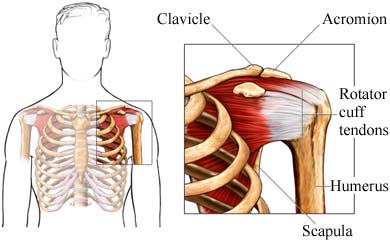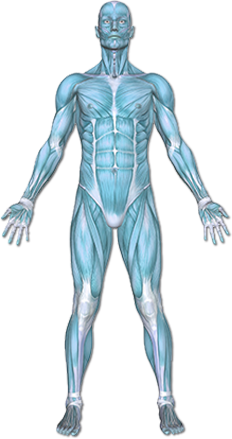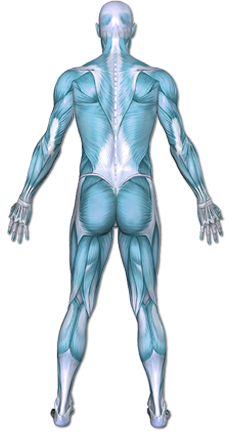Biceps Tendinitis
The tendons connect muscle to bone and often connect near a joint. Tendinopathy is an injury to the tendon. It can cause pain and swelling and makes it difficult to move. Tendinopathy may be:
- Tendinitis—inflammation of the tendon. (less common)
- Tendinosis—tiny tears in the tendon with no significant inflammation. (more common)
There are several tendons in the shoulder. They are attached to muscles of the rotator cuff and the biceps muscle of the arm.


Copyright © Nucleus Medical Media, Inc.
This content was created using EBSCO’s Health Library
Tendinopathy is generally caused by overuse of a muscle and tendon. Over time, the strain on the tendon causes the structure of the tendon to change. Shoulder tendons are overused most often with:
- Repeated reaching overhead
- Repeated throwing
Shoulder tendinopathy may also be caused by:
- Inflammatory disease in the shoulder such as arthritis
- Trauma to the shoulder or fall on outstretched arms.
- Normal wear and tear associated with age
This content was created using EBSCO’s Health Library
Factors that increase your chance of developing shoulder tendinopathy include:
- Age: 30 and over
- Frequently using the arm in an overhead position or throwing motion, as in:
- Tennis or other racquet sports
- Swimming
- Baseball
- Jobs (eg, overhead assembly work, butchering, or using an overhead pressing machine)
This content was created using EBSCO’s Health Library
Symptoms develop gradually over time. Pain usually slowly increases with use. Tendinopathy may cause:
- Pain (a dull ache) in the shoulder and upper arm
- Pain at night, especially when sleeping on the injured side
- Pain when trying to reach for a back zipper or pocket
- Pain with overhead use of the arm
- Shoulder weakness, usually due to pain with effort
- Shoulder stiffness with some loss of motion
This content was created using EBSCO’s Health Library
The doctor will ask about your symptoms and medical history. A physical exam will be done. Your doctor will check tender areas. Your shoulder range of motion, and muscle strength will also be checked. Your doctor may need to get detailed images of your shoulder. This may be done if the injury is severe or to rule out other problems. Images can be taken with:
- MRI scan
- Arthroscopy —a surgery that is done with a scope
- X-rays
- CT arthrography—specialized x-ray
Bursitis can cause similar pain symptoms. Your doctor may inject an anesthetic medication. If the pain goes away it may suggest bursitis not tendinopathy.
This content was created using EBSCO’s Health Library
- Bicipital Tendinitis is commonly diagnosed through clinical evaluation but confirmed through x-ray, MRI or CT scan. The x-ray may show bony growth near the bicipital tunnel and the MRI or CT would show inflammation or tearing of the tissues.
Non-operative treatment
- Conservative treatment of biceps tendinitis is likely to center around reducing the damaging positions in the individual’s activities of daily living. Ergonomic evaluation of your workstation will improve the sustained positioning of the shoulder and likely have the most benefit. The therapist will recommend preventive stretches, use of home modalities like ice and heat and the use of rest breaks to control inflammation. Positional changes in sleeping and driving can also make a big difference in activity tolerance. Conservative management may also include use of non-steroidal anti-inflammatory medications and/or steroid injections to reduce inflammation and pain at the shoulder.
Surgical treatment
- If conservative management is not successful after 3 months, a physician may evaluate for surgery. Surgery would be indicated when the biceps has torn 25-50% off of the bone or the biceps tendon is chronically outside the bicipital groove. The three major types of surgery are tenotomy, repair and tenodesis. Tenotomy refers to the cutting of the tendon off of the bone to improve pain. It is most commonly performed in adults over the age of 65. Following the surgery, motion of the elbow and shoulder will not be significantly limited due to the strength of the other shoulder muscles that can take up the slack. The long head of the biceps is allowed to fall and will have a noticeable lump on the front of the forearm.
- A tenodesis procedure cuts out the damaged part of the tendon and repairs the remaining part back to the bone. This is more common for patients who are younger than 65 years old or are very physically active. A repair of the tendon will be necessary if there has been a traumatic injury that has pulled part of the tendon off of the bone or if the biceps tendon tear is part of a larger rotator cuff tear.
- The rehabilitation of a surgically-repaired biceps tendon would mimic a rotator cuff protocol, protecting the tissues until adequate healing has occurred. The therapist will recommend specific stretch and gliding techniques to make sure that the tendon does not become encapsulated in scar tissue as it heals.
This content was created using EBSCO’s Health Library
To protect the shoulder from injury:
- Do regular resistance exercises to strengthen the muscles.
- Use proper athletic training methods.
- Do not increase exercise duration or intensity more than 10% per week.
- Avoid overusing your arm in an overhead position.
- Alter job duties to reduce overhead activity.
- Do not ignore or try to work through shoulder pain.
This content was created using EBSCO’s Health Library
This content was created using EBSCO’s Health Library
RESOURCES:
- American Academy of Orthopaedic Surgeons
http://www.aaos.org/
- The American Orthopaedic Society for Sports Medicine
http://www.aossm.org
CANADIAN RESOURCES:
- Canadian Orthopaedic Association
- Canadian Orthopaedic Foundation
http://www.canorth.org/
REFERENCES:
- Bicpes tendinopathy. EBSCO DynaMed website. Available at: http://www.ebscohost.com/dynamed/what.php . Updated September 6, 2012. Accessed December 28, 2012.
- Bursitis and tendinitis. National Institue of Arthritis and Musculoskeletal and Skin Diseases website. Available at: http://www.niams.nih.gov/Health_Info/Bursitis/default.asp . Accessed December 28, 2012.
- Shoulder tendinitis. Cleveland Clinic website. Available at: http://my.clevelan… . Accessed December 28, 2012.
- Rotator Cuff Tendinitis. American Academy of Orthopaedic Surgeons website. Available at: http://orthoinfo.aaos.org/topic.cfm?topic=A00032 . Accessed December 28, 2012.
- 10/26/2010 DynaMed’s Systematic Literature Surveillance http://www.ebscohost.com/dynamed/what.php : Massey T, Derry S, Moore R, McQuay H. Topical NSAIDs for acute pain in adults. Cochrane Database Syst Rev. 2010;(6):CD007402.
- Bachoura A, Sasaki K, Kamineni S. (2013). Analysis of age-related degenerative changes of the biceps brachii distal footprint. J Surg Orthop Adv. 22(4):304-9.
- Huang SW, Wang WT. (2013). Quantitative diagnostic method for biceps long head tendinitis by using ultrasound. Scientific World Journal. Dec 7:2013.
- Scully WF, Wilson DJ, Grassbaugh JA, Branstetter JG, Marchant BG, Arrington ED. (2013). A simple surgical technique for subpectoral biceps tenodesis using a double-loaded suture anchor. Arthosoc Tech May 23:2(2):e191-6.
- Wu PT, Jou IM, Yang CC, Lin CJ, Su FC, Su WR. (2014). The severity of the long head biceps tendinopathy in patient with chronic rotator cuff tears: Macroscopic versus microscopic results. J Shoulder Elbow Surgery. Feb 1.
This content was created using EBSCO’s Health Library


